Roy Ganz
DocVLM: Make Your VLM an Efficient Reader
Dec 11, 2024



Abstract:Vision-Language Models (VLMs) excel in diverse visual tasks but face challenges in document understanding, which requires fine-grained text processing. While typical visual tasks perform well with low-resolution inputs, reading-intensive applications demand high-resolution, resulting in significant computational overhead. Using OCR-extracted text in VLM prompts partially addresses this issue but underperforms compared to full-resolution counterpart, as it lacks the complete visual context needed for optimal performance. We introduce DocVLM, a method that integrates an OCR-based modality into VLMs to enhance document processing while preserving original weights. Our approach employs an OCR encoder to capture textual content and layout, compressing these into a compact set of learned queries incorporated into the VLM. Comprehensive evaluations across leading VLMs show that DocVLM significantly reduces reliance on high-resolution images for document understanding. In limited-token regimes (448$\times$448), DocVLM with 64 learned queries improves DocVQA results from 56.0% to 86.6% when integrated with InternVL2 and from 84.4% to 91.2% with Qwen2-VL. In LLaVA-OneVision, DocVLM achieves improved results while using 80% less image tokens. The reduced token usage allows processing multiple pages effectively, showing impressive zero-shot results on DUDE and state-of-the-art performance on MP-DocVQA, highlighting DocVLM's potential for applications requiring high-performance and efficiency.
TAP-VL: Text Layout-Aware Pre-training for Enriched Vision-Language Models
Nov 07, 2024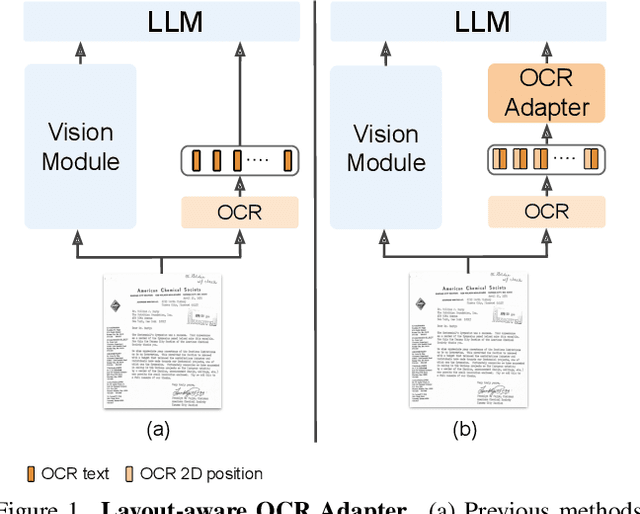
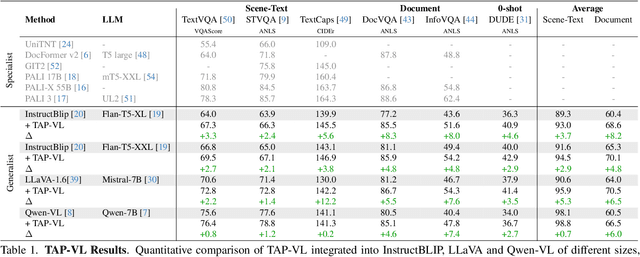
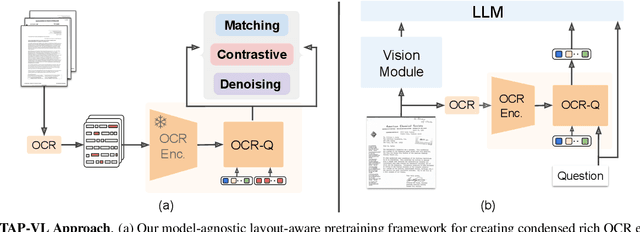
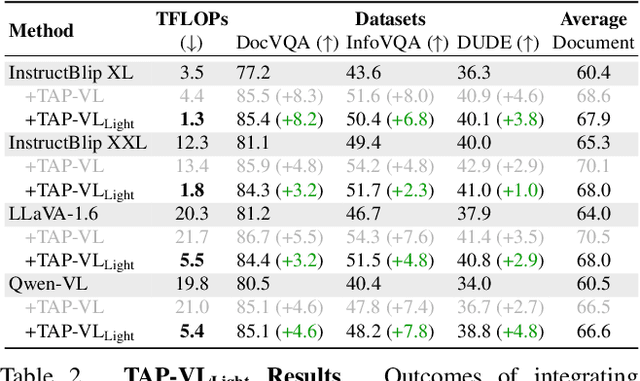
Abstract:Vision-Language (VL) models have garnered considerable research interest; however, they still face challenges in effectively handling text within images. To address this limitation, researchers have developed two approaches. The first method involves utilizing external Optical Character Recognition (OCR) tools to extract textual information from images, which is then prepended to other textual inputs. The second strategy focuses on employing extremely high-resolution images to improve text recognition capabilities. In this paper, we focus on enhancing the first strategy by introducing a novel method, named TAP-VL, which treats OCR information as a distinct modality and seamlessly integrates it into any VL model. TAP-VL employs a lightweight transformer-based OCR module to receive OCR with layout information, compressing it into a short fixed-length sequence for input into the LLM. Initially, we conduct model-agnostic pretraining of the OCR module on unlabeled documents, followed by its integration into any VL architecture through brief fine-tuning. Extensive experiments demonstrate consistent performance improvements when applying TAP-VL to top-performing VL models, across scene-text and document-based VL benchmarks.
Text-to-Image Generation Via Energy-Based CLIP
Aug 30, 2024



Abstract:Joint Energy Models (JEMs), while drawing significant research attention, have not been successfully scaled to real-world, high-resolution datasets. We present EB-CLIP, a novel approach extending JEMs to the multimodal vision-language domain using CLIP, integrating both generative and discriminative objectives. For the generative objective, we introduce an image-text joint-energy function based on Cosine similarity in the CLIP space, training CLIP to assign low energy to real image-caption pairs and high energy otherwise. For the discriminative objective, we employ contrastive adversarial loss, extending the adversarial training objective to the multimodal domain. EB-CLIP not only generates realistic images from text but also achieves competitive results on the compositionality benchmark, outperforming leading methods with fewer parameters. Additionally, we demonstrate the superior guidance capability of EB-CLIP by enhancing CLIP-based generative frameworks and converting unconditional diffusion models to text-based ones. Lastly, we show that EB-CLIP can serve as a more robust evaluation metric for text-to-image generative tasks than CLIP.
Adversaries With Incentives: A Strategic Alternative to Adversarial Robustness
Jun 17, 2024Abstract:Adversarial training aims to defend against *adversaries*: malicious opponents whose sole aim is to harm predictive performance in any way possible - a rather harsh perspective, which we assert results in unnecessarily conservative models. Instead, we propose to model opponents as simply pursuing their own goals, rather than working directly against the classifier. Employing tools from strategic modeling, our approach uses knowledge or beliefs regarding the opponent's possible incentives as inductive bias for learning. Our method of *strategic training* is designed to defend against opponents within an *incentive uncertainty set*: this resorts to adversarial learning when the set is maximal, but offers potential gains when it can be appropriately reduced. We conduct a series of experiments that show how even mild knowledge regarding the adversary's incentives can be useful, and that the degree of potential gains depends on how incentives relate to the structure of the learning task.
Enhancing Consistency-Based Image Generation via Adversarialy-Trained Classification and Energy-Based Discrimination
May 25, 2024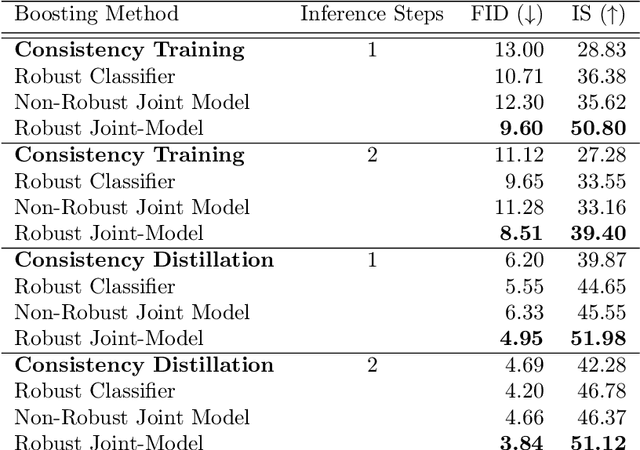
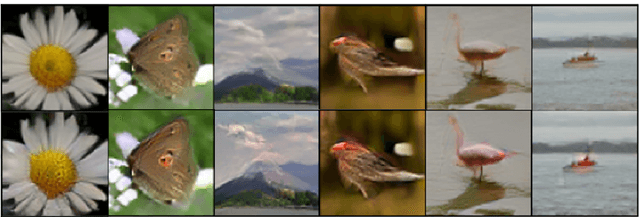
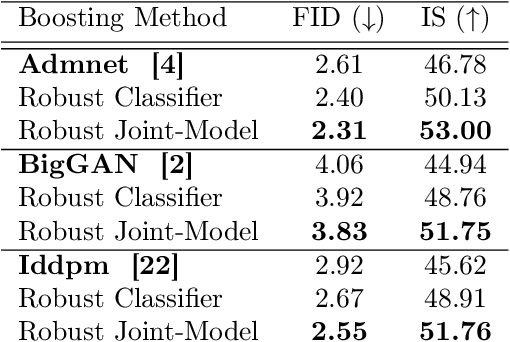
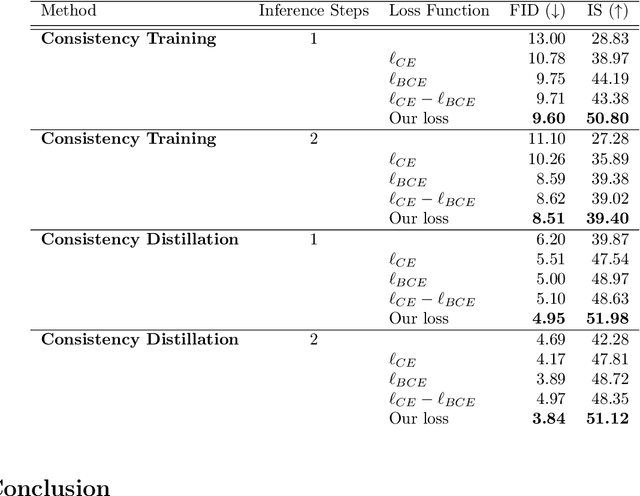
Abstract:The recently introduced Consistency models pose an efficient alternative to diffusion algorithms, enabling rapid and good quality image synthesis. These methods overcome the slowness of diffusion models by directly mapping noise to data, while maintaining a (relatively) simpler training. Consistency models enable a fast one- or few-step generation, but they typically fall somewhat short in sample quality when compared to their diffusion origins. In this work we propose a novel and highly effective technique for post-processing Consistency-based generated images, enhancing their perceptual quality. Our approach utilizes a joint classifier-discriminator model, in which both portions are trained adversarially. While the classifier aims to grade an image based on its assignment to a designated class, the discriminator portion of the very same network leverages the softmax values to assess the proximity of the input image to the targeted data manifold, thereby serving as an Energy-based Model. By employing example-specific projected gradient iterations under the guidance of this joint machine, we refine synthesized images and achieve an improved FID scores on the ImageNet 64x64 dataset for both Consistency-Training and Consistency-Distillation techniques.
Paint by Inpaint: Learning to Add Image Objects by Removing Them First
Apr 28, 2024
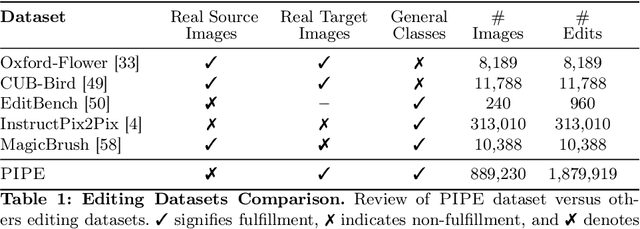

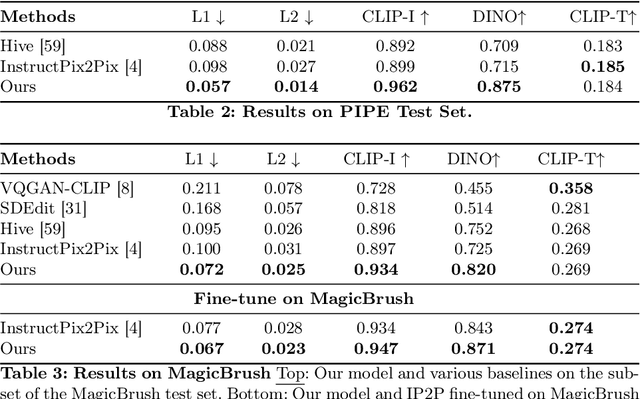
Abstract:Image editing has advanced significantly with the introduction of text-conditioned diffusion models. Despite this progress, seamlessly adding objects to images based on textual instructions without requiring user-provided input masks remains a challenge. We address this by leveraging the insight that removing objects (Inpaint) is significantly simpler than its inverse process of adding them (Paint), attributed to the utilization of segmentation mask datasets alongside inpainting models that inpaint within these masks. Capitalizing on this realization, by implementing an automated and extensive pipeline, we curate a filtered large-scale image dataset containing pairs of images and their corresponding object-removed versions. Using these pairs, we train a diffusion model to inverse the inpainting process, effectively adding objects into images. Unlike other editing datasets, ours features natural target images instead of synthetic ones; moreover, it maintains consistency between source and target by construction. Additionally, we utilize a large Vision-Language Model to provide detailed descriptions of the removed objects and a Large Language Model to convert these descriptions into diverse, natural-language instructions. We show that the trained model surpasses existing ones both qualitatively and quantitatively, and release the large-scale dataset alongside the trained models for the community.
Question Aware Vision Transformer for Multimodal Reasoning
Feb 08, 2024


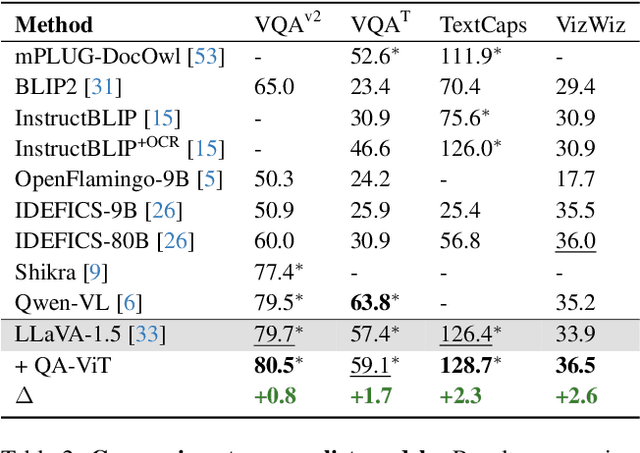
Abstract:Vision-Language (VL) models have gained significant research focus, enabling remarkable advances in multimodal reasoning. These architectures typically comprise a vision encoder, a Large Language Model (LLM), and a projection module that aligns visual features with the LLM's representation space. Despite their success, a critical limitation persists: the vision encoding process remains decoupled from user queries, often in the form of image-related questions. Consequently, the resulting visual features may not be optimally attuned to the query-specific elements of the image. To address this, we introduce QA-ViT, a Question Aware Vision Transformer approach for multimodal reasoning, which embeds question awareness directly within the vision encoder. This integration results in dynamic visual features focusing on relevant image aspects to the posed question. QA-ViT is model-agnostic and can be incorporated efficiently into any VL architecture. Extensive experiments demonstrate the effectiveness of applying our method to various multimodal architectures, leading to consistent improvement across diverse tasks and showcasing its potential for enhancing visual and scene-text understanding.
GRAM: Global Reasoning for Multi-Page VQA
Jan 07, 2024



Abstract:The increasing use of transformer-based large language models brings forward the challenge of processing long sequences. In document visual question answering (DocVQA), leading methods focus on the single-page setting, while documents can span hundreds of pages. We present GRAM, a method that seamlessly extends pre-trained single-page models to the multi-page setting, without requiring computationally-heavy pretraining. To do so, we leverage a single-page encoder for local page-level understanding, and enhance it with document-level designated layers and learnable tokens, facilitating the flow of information across pages for global reasoning. To enforce our model to utilize the newly introduced document-level tokens, we propose a tailored bias adaptation method. For additional computational savings during decoding, we introduce an optional compression stage using our C-Former model, which reduces the encoded sequence length, thereby allowing a tradeoff between quality and latency. Extensive experiments showcase GRAM's state-of-the-art performance on the benchmarks for multi-page DocVQA, demonstrating the effectiveness of our approach.
CLIPAG: Towards Generator-Free Text-to-Image Generation
Jun 29, 2023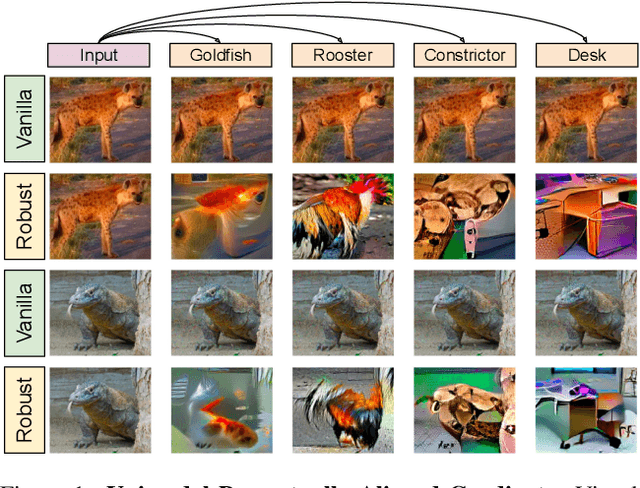
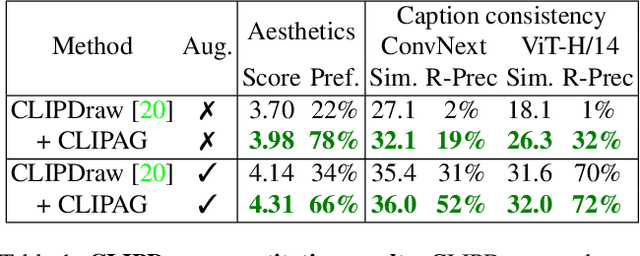
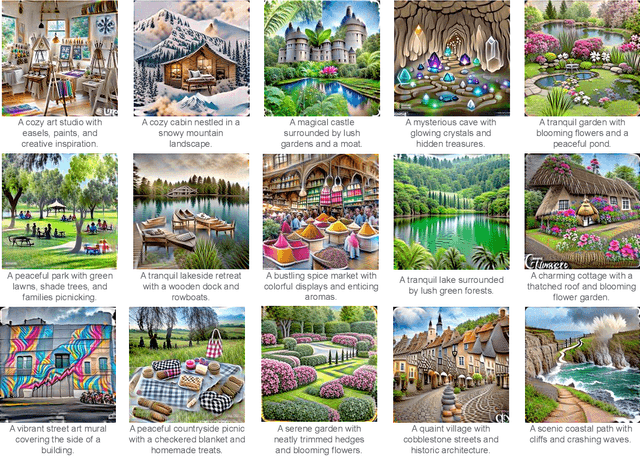
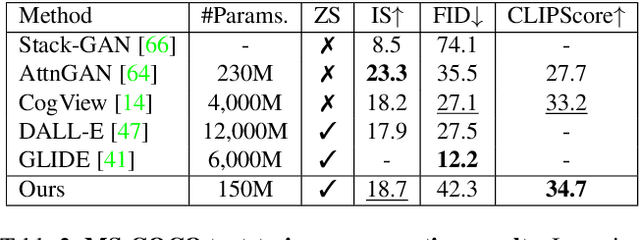
Abstract:Perceptually Aligned Gradients (PAG) refer to an intriguing property observed in robust image classification models, wherein their input gradients align with human perception and pose semantic meanings. While this phenomenon has gained significant research attention, it was solely studied in the context of unimodal vision-only architectures. In this work, we extend the study of PAG to Vision-Language architectures, which form the foundations for diverse image-text tasks and applications. Through an adversarial robustification finetuning of CLIP, we demonstrate that robust Vision-Language models exhibit PAG in contrast to their vanilla counterparts. This work reveals the merits of CLIP with PAG (CLIPAG) in several vision-language generative tasks. Notably, we show that seamlessly integrating CLIPAG in a "plug-n-play" manner leads to substantial improvements in vision-language generative applications. Furthermore, leveraging its PAG property, CLIPAG enables text-to-image generation without any generative model, which typically requires huge generators.
FuseCap: Leveraging Large Language Models to Fuse Visual Data into Enriched Image Captions
May 28, 2023Abstract:Image captioning is a central task in computer vision which has experienced substantial progress following the advent of vision-language pre-training techniques. In this paper, we highlight a frequently overlooked limitation of captioning models that often fail to capture semantically significant elements. This drawback can be traced back to the text-image datasets; while their captions typically offer a general depiction of image content, they frequently omit salient details. To mitigate this limitation, we propose FuseCap - a novel method for enriching captions with additional visual information, obtained from vision experts, such as object detectors, attribute recognizers, and Optical Character Recognizers (OCR). Our approach fuses the outputs of such vision experts with the original caption using a large language model (LLM), yielding enriched captions that present a comprehensive image description. We validate the effectiveness of the proposed caption enrichment method through both quantitative and qualitative analysis. Our method is then used to curate the training set of a captioning model based BLIP which surpasses current state-of-the-art approaches in generating accurate and detailed captions while using significantly fewer parameters and training data. As additional contributions, we provide a dataset comprising of 12M image-enriched caption pairs and show that the proposed method largely improves image-text retrieval.
 Add to Chrome
Add to Chrome Add to Firefox
Add to Firefox Add to Edge
Add to Edge